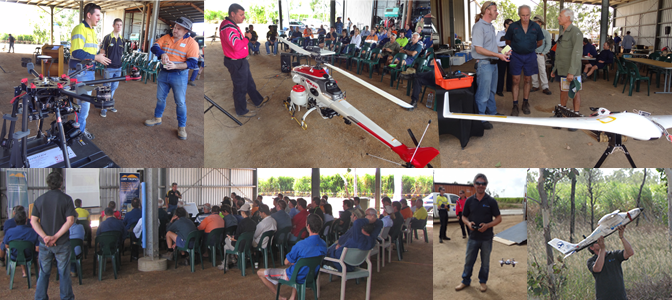Unmanned aerial vehicle display brings a glimpse of the future to the Burdekin
The emerging Unmanned Aerial Vehicles (UAV) industry could have a major impact on agricultural practices, and the Drone Field Day on 25 May at the Barattas gave Burdekin sugarcane farmers the opportunity to see them in action.
The NQ Dry Tropics event, part of its Sugarcane Innovations Program, attracted more than
60 people including farmers, industry staff, government representatives, researchers and local business people.
Using innovation to reduce the impact of nutrients and pesticides from the sugarcane industry on the Great Barrier Reef is one of the core outcomes of the NQ Dry Tropics Sugarcane Innovation Program. NQ Dry Tropics delivered this field day through funding from the Australian Government Reef Programme.
Five presenters from the UAV industry spoke about the many potential applications of UAVs, from targeted crop spraying in inaccessible areas, to highly-accurate 3D mapping of an entire property.
- Larry Lawrence from BMS Laser Sat spoke about the Trimble’s UX5 Unmanned Aerial System,
- Ashley Walker from NQUAV discussed the current Civil Aviation Safety Authority (CASA) rules and regulations, and touched on what’s coming in the future, in particular Hyperspectral imaging and its potential capabilities,
- Daniel Parfitt from Aerial Image Works presented on his sophisticated Bramor rTK UAV and its scanning capability through Near-infrared (NIR), Normalised Difference Vegetation Index (NDVI) and Light Detection and Ranging (LIDAR) systems,
- Adrian Plahn from WASPNQ, spoke about the Yamaha Rmax and MR7 multi rotor UAV, used for aerial spraying, seeding & granules application, photography, mapping and real time visual feedback to farmers wanting to inspect their property, and
- Matt Ewing from Airmap3D showcased the potential for using UAVs in survey work and the incredible details that can be generated into 3D images of properties.

Event organiser Anthony Curro said that there was a growing interest in the Burdekin sugarcane industry around UAVs and their potential applications for agriculture:
”We received some great feedback today from participants who appreciated the chance to see this technology close up”, he said.
“Many were interested to know how the vast array of data that these UAVs provide can be interpreted and turned into something that can be practically applied to improve crop health, monitor moisture levels, and assist with nutrient and pesticide applications”.
“One good suggestion was that sugarcane industry staff, particularly agronomists, could have an important role to play by interpreting this data and coming up with models to assist with these issues”, he said.
